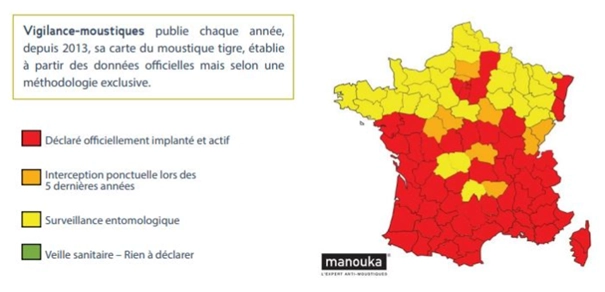|
The Qista team wishes you a very happy festive season! Our offices will be closed from 20 December 2025 to 4 January 2025 inclusive.
|
Home / Mosquito Information / The tiger mosquito makes a comeback in France
Find out how the tiger mosquito has become established in France. Despite its small size, the dangerous and invasive tiger mosquito could do serious harm this summer of 2021. Hot weather means the return of the tiger mosquito to France. This year, 63 departments are classified as red zones on the map drawn up by Vigilance-Moustique.
In 2020, the mosquito continues its meteoric rise in France, with 63 departments now under red alert. The invasion is impressive, with 6 new departments under red alert compared with 2020. In the end, the tiger mosquito has invaded 69 départements, or 67% of France. In the Grand Sud region, all the departments have been colonised by this pest! This mosquito does not travel more than 100 metres from its birthplace. However, it can be easily transported over long distances by car or train. This has enabled the tiger mosquito to reach Paris and the whole of the Ile-de-France region in 2019. In addition, global warming in recent years partly explains the rapid spread of the tiger mosquito across France.

With its scientific name of Aedes albopictus, the tiger mosquito is a diurnal insect. It loves to bite during the day and mainly outdoors. Easily recognisable by its black and white stripes, it is adept at temporarily flooded environments and warm, humid areas. So it’s easy to find it in urban areas! Coming straight from Asia, the tiger mosquito can be found from March to the end of October. This highly aggressive mosquito is capable of biting the same person 4 or 5 times. They are particularly keen on the edges of flooded surfaces, which is a popular place for the female to lay her eggs. Although the female tiger mosquito only lives for a few weeks, her eggs can wait patiently for several months (an entire winter) for the right conditions to hatch!